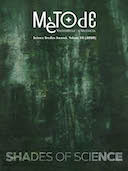The energy crossroads: Strategies for sustainable energy development
DOI:
https://doi.org/10.7203/metode.10.12469Keywords:
energy, climate change, energy transition, sustainable development Abstract
Abstract
Energy is the blood that moves today’s society and is one of the factors that has decisively contributed to improving humanity’s quality of life. The energy needs of the world’s population are expected to double by 2050 and so, considering that available fossil fuels are becoming exhausted, as well as their negative environmental impact, new strategies are needed for sustainable development. This paper addresses the potential challenges and opportunities in the development of global energy systems, emphasising how deeply interconnected the energy and climate debates are.
 Downloads
Downloads
 References
References
Alonso Garrido, A. (2012). La energía como elemento esencial de desarrollo. Consecuencias de un modelo energético insostenible. Madrid: Asociación de Ingenieros Industriales de Madrid. Retrieved from http://aiim.es/wp-content/uploads/2016/06/La-energ%C3%ADa-como-elemento-esencial-de-desarrolo..pdf
Bret, A. (2014). The energy-climate continuum: Lessons from basic science and history. Cham/Heidelberg/New York/Dordrecht/London: Springer. doi: 10.1007/978-3-319-07920-2
Cifarelli, L., Wagner, F., & Wiersma, D. S. (2013). New strategies for energy generation, conversion and storage. Lecture notes Joint EPS-SIF International School on Energy, Varenna 2012. Bologna: SIF.
International Energy Agency. (2015). Energy and climate change. Paris: OECD/IEA. Retrieved from http://www.iea.org/publications/freepublications/publication/WEO2015SpecialReportonEnergyandClimateChange.pdf
International Energy Agency. (2017). Key world energy statistics. Paris: IEA. Retrieved from http://www.iea.org/publications/freepublications/publication/KeyWorld2017.pdf
IPCC. (2014). Summary for policymakers. In O. Edenhofer et al. (Eds.), Climate change 2014: Mitigation of climate change. Working group III contribution of to the Fifth Assessment Report of the Intergovernmental Panel on Climate Change. Cambridge, RU and New York, NY, EUA: Cambridge University Press.
MacKay, D. J. C. (2009). Sustainable energy – Without the hot air. Cambridge: UIT Cambridge.
Muraoka, K., Wagner, F., Yamagata, Y., & Donné, A. J. H. (2016). Short- and long-range energy strategies for Japan and the world after the Fukushima nuclear accident. Journal of Instrumentation, 11, C01082. doi: 10.1088/1748-0221/11/01/C01082
Romanelli, F. (Ed.). (2012). Fusion electricity. A roadmap to the realisation of fusion energy. European Fusion Development Agreement. Retrieved from https://www.euro-fusion.org/fileadmin/user_upload/EUROfusion/
Documents/Roadmap.pdf
Downloads
Published
How to Cite
-
Abstract1723
-
PDF728
Issue
Section
License
![]()
All the documents in the OJS platform are open access and property of their respective authors.
Authors publishing in the journal agree to the following terms:
- Authors keep the rights and guarantee Metode Science Studies Journal the right to be the first publication of the document, licensed under a Creative Commons Attribution-NonCommercial-NoDerivatives 4.0 International License that allows others to share the work with an acknowledgement of authorship and publication in the journal.
- Authors are allowed and encouraged to spread their work through electronic means using personal or institutional websites (institutional open archives, personal websites or professional and academic networks profiles) once the text has been published.





